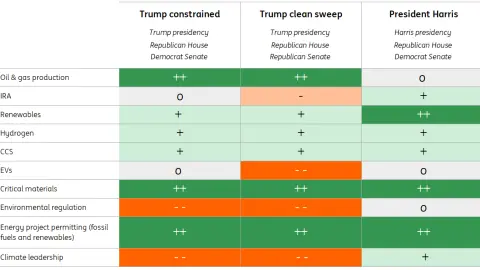Trump constrained scenario: energy dominance and transition in parallel
The US energy transition is expected to slow down due to weakened regulation and funding support. However, the Inflation Reduction Act (IRA) is likely to survive because of its job creation and economic benefits. Nonetheless, without a comprehensive climate policy ecosystem, the US green agenda may become obscured
Under a second term for Trump – even without Republican control of Congress – the speed of decarbonisation in the US will slow down due to weakened energy and environmental regulation, clean energy funding support, and international climate leadership. Nevertheless, the IRA is likely to survive given the economic benefits it can create. Still, without a comprehensive climate policy ecosystem, the US green agenda may become obscured.
Oil and gas
We could witness reinforced US energy dominance through increased oil and gas production and exports. This includes promoting LNG production, contrary to Biden’s moratorium on licensing new LNG exports, which was recently halted by a federal judge. It also involves cancelling methane regulations and streamlining the authorisation process for new oil and gas exploration and infrastructure projects.
IRA
The IRA is unlikely to be completely repealed. Only Congress can vote to repeal the IRA – or indeed any legislation – and this would be hard to achieve under a split or Democrat-controlled Congress. Plus, Republican states have been huge beneficiaries of the IRA, with about 80% of announced investment in clean energy flowing into Republication congressional districts and creating green jobs.
The legislation has also gained popularity among corporations and investors, and they would be reluctant to see the financial incentives go. Think about Obamacare: Trump was keen to strike it down as president, but Congress was not able to repeal it as the law gradually became more popular thanks to the public buy-in of its benefits.
However, the implementation of the IRA will become harder. The qualifying rules for certain tax credits could become stricter, especially around using domestically produced content for clean energy manufacturing. There would be little focus on equipping government staff with the know-how to review clean energy funding applications. As a result, we could see longer application timelines slowing down project development.
Moreover, while the IRA itself is likely to survive, as much as 30% of the energy and climate-related funding under the IRA is at various degrees of risk of being scaled back. Several tax credits, especially the consumer electric vehicle (EV) tax credits that have an initial spending estimate of $12bn, can be rolled back. The $100bn non-tax credit funding, including loans and loan guarantees from the Department of Energy’s (DOE’s) Loan Programs Office (LPO), as well as dedicated grants toward environmental justice, may also be lowered, if not stalled. The DOE has committed about $30bn of clean energy loans and loan guarantees to companies, but has only started lending around $6.5bn.
The tax credits that are likely to remain unchanged include those for carbon capture and storage (CCS), hydrogen, renewable power, nuclear, and manufacturing, among others (this will be further analysed in the following sections). It is worth noting, however, that since the tax credits under the IRA are non-capped, the actual spending can be a lot higher, potentially adding more pressure to fiscal sustainability and hence spending compromises.
Breakdown of initial energy and climate related spending estimates under the IRA

EVs
The EV industry has been a punching bag of Trump’s campaign, with his team declaring on the Republican policy platform to reverse Biden’s EV policy and scrap the nationwide EV production and sales targets.
As such, EV tax credits are highly likely to be scaled back. Plus, these tax credits are consumer-based, not manufacturer-based, and may be repealed more easily with softer business pushback. This can be done through tightening tax credit eligibility guidelines. It can also be done by putting a cap on the number of EVs allowed to receive EV tax credits.
Moreover, the funding for developing the National Electric Vehicle Infrastructure (NEVI) programme under the Infrastructure Investment and Jobs Act (IIJA) will likely be lowered because of the unpopularity of EVs among Republicans and the slow speed of funding being distributed to projects.
Lastly, the Environmental Protection Agency‘s (EPA’s) strictest-ever proposed rule on vehicle emissions standards, aimed at boosting EV demand, is also likely to be reversed, even though car manufacturers may have already made investment decisions to reduce tailpipe emissions.
Car manufacturers remain committed to electrifying their fleet, despite some recent delay in EV production targets. However, a lack of direct EV support, especially from the infrastructure side, would mean a slower deployment rate overall.
Renewable power
The centrepiece policies that have led to massive development in renewable technologies and project finance are the renewable power Production Tax Credits (PTCs) and Investment Tax Credits (ITCs). Enacted in 1992 and 2005, respectively, the PTCs and ITCs have been extended under the IRA until 2032, but starting in 2025, these credits will become "technology-neutral" as long as a project can demonstrate it has zero or negative emissions.
This means that a wider range of technologies – including solar, wind, hydropower, geothermal, marine, nuclear, and waste energy recovery – will become eligible. Notably, combustion and gasification (C&G) facilities can also potentially qualify for the credits. The technology-neutral tax credits are set to start phasing out after 2032, or when emissions from the US power sector have dropped to below 25% of 2022’s emissions level, whichever comes later.
The technology-neutral tax credits will likely survive if Trump wins but Republicans fail to control Congress. This is because even under the first Trump administration, the technology-specific ITCs and PTCs were not repealed and solar and wind continued to develop steadily. Furthermore, the expansion of eligibility under the technology-neutral tax credits can benefit non-renewable zero-emission projects, a provision that may be welcomed by Republicans.
These positive spins do not mean that the industry will get sufficient support to accelerate clean power development. We would expect less effort to re-train government staff, build transmission lines, or reform the grid. There could also be more gas-fired power plants approved to support increasing electricity demand.
Hydrogen and CCS
Hydrogen (especially blue hydrogen) and carbon capture and storage (CCS) will gain continued support, as these technologies can provide business opportunities to oil and gas companies and heavier industries. Hydrogen and CCS hubs would continue to develop in this case, with permitting reforms potentially improving the regulatory conditions for CCS project development. A potential downside risk is that any cuts in the DOE’s Loan Program Office’s (LPO’s) loans or loan guarantees would affect the funding for these projects.
Critical minerals
For Trump, onshoring manufacturing and protecting key sectors would be a priority. This means enhanced protectionist efforts such as import tariffs in favour of batteries and critical minerals. Trump is now proposing to impose a 10% tariff on all goods and a 60% tariff on all Chinese goods.
Less competition in the US could strengthen domestic clean energy supply chains, but questions remain as to how fast they can be built up. China’s absolute dominance in critical minerals means that the US may face sourcing challenges and need to accelerate partnerships with other suppliers. Thus, the US could in the short to medium term bear higher costs in the energy transition.
Regulation
There would be substantial rollbacks of punitive regulations that limit dirty economic activities. For instance, there could be cancellations on Biden’s effort to charge a fee on methane emissions from the oil and gas industry. The EPA’s rule on vehicle emissions standards is also likely to be reversed.
The EPA’s newly finalised regulation to reduce emissions from coal and gas-fired power plants in the 2030s unless they can demonstrate deep emissions reduction is also at a high risk of being overturned.
Climate leadership
Regardless of which party controls Congress under a second Trump administration, we would see the US retreat from international climate leadership. This features a second withdrawal from the Paris Agreement, withdrawal from potential commitments such as a recent one (under discussion) to the UN Treaty to End Plastic Pollution, stalled or even cancelled efforts to mandate climate data disclosure, and less clean energy technology innovation, among others.
This publication has been prepared by ING solely for information purposes irrespective of a particular user's means, financial situation or investment objectives. The information does not constitute investment recommendation, and nor is it investment, legal or tax advice or an offer or solicitation to purchase or sell any financial instrument. Read more
Download
Download article
10 September 2024
US election scenarios and how they’ll impact energy and climate policy This bundle contains 4 Articles